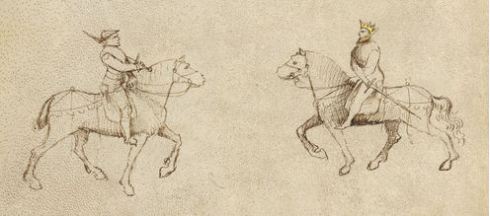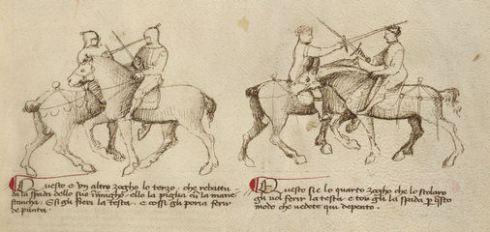Getting back to the subject I’ve already discussed briefly in here. I’ve seen quite a few training videos and material from show tournaments and melees that exhibit circling motion, i.e. riders going around each other and fencing from there. It has its place in shows and demonstrations, yes. But I’ve already mentioned why I don’t like this sort of training myself. Most importantly, it creates a false sense of flow and false sense of actual fencing. It also makes getting the timing and measure correct more difficult, making it perhaps more suitable for advanced exercises only.
When compared to the usual way we train swordsmanship, this is clear. We need to have a line of attack (or parry) and around that line we can construct an action that has correct measure, timing and structure. These things may become more fluid and nuanced due to training, but they need to be there when practicing the basics. Same goes for mounted fencing; you need to train in the correct line of action to teach yourself how to do it properly.
Fiore shows this in his treatise very clearly from start to finish. He also begins sword versus sword on horseback similarly.

“Also, this same guard of Coda Longa is good when someone comes towards you with the sword to the reverse hand side, as this enemy of mine is coming.” Getty, translation by Easton & Durban
What follows are several plays from the same line of action.

Left: “This is the first play of the guard of Coda Longa which is before, that is, the Master rebats his enemy’s sword and thrusts him in the chest, or in the face, as it is drawn here.” Right: “This is the second play, and to rebat it, I hit this one in the head, as I can see well that his head is not armoured”. Getty, translation by Easton & Durban
And so on. What we clearly see, is an action (or several) happening in a line. Fiore doesn’t specifically say NOT to go in circles, but Dom Duarte does. In his unfinished book “Livro da Ensinança de Bem Cavalgar Toda Sela” (“The Art of Riding on Every Saddle”) from 1434-1438 he discusses the use of sword in tournaments. He states: “And to have time to prepare yourself, you should not make (in important tournaments, with many riders) short turns with your horse.” He goes on to add that this way the horse stays strong and so does your arm. He also mentions easily noticeable performance and stronger hits as advantages of riding in straight, longer lines of attack. One may argue he indeed only discusses melees and tournaments, which are not the context Fiore’s work is set in, but he makes a point.
There are also other, horse-related, advantages to this. Your horse will learn to approach and to pass other horses close enough for fencing but also keep themselves (and you) safe from possible kicking. Riding in circles makes it much easier for a horse to kick another horse’s face and breast. Passing in straight line is safer as the horses also have their own line to approach and to pass. Start in walk and advance to trot (and canter) when you are ready.
So, for the aforementioned reasons I would suggest direct lines of action when training mounted combat and getting the plays correct. Also train the plays dismounted, learn the mechanics and perhaps try them on wooden horses first before moving on to your hoofed friend. 🙂
